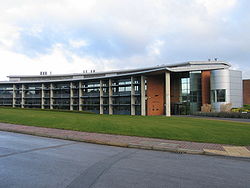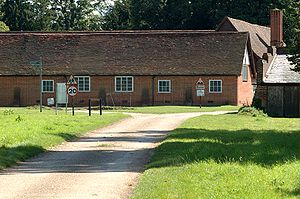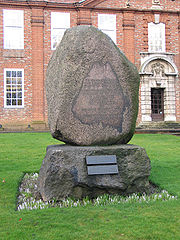
Rothamsted Experimental Station
Encyclopedia

Agricultural experiment station
An agricultural experiment station is a research center that conducts scientific investigations to solve problems and suggest improvements in the food and agriculture industry...
in the world, is located at Harpenden
Harpenden
Harpenden is a town in Hertfordshire, England.The town's total population is just under 30,000.-Geography and administration:There are two civil parishes: Harpenden and Harpenden Rural....
in Hertfordshire
Hertfordshire
Hertfordshire is a ceremonial and non-metropolitan county in the East region of England. The county town is Hertford.The county is one of the Home Counties and lies inland, bordered by Greater London , Buckinghamshire , Bedfordshire , Cambridgeshire and...
, England
England
England is a country that is part of the United Kingdom. It shares land borders with Scotland to the north and Wales to the west; the Irish Sea is to the north west, the Celtic Sea to the south west, with the North Sea to the east and the English Channel to the south separating it from continental...
. It is now known as Rothamsted Research. The Park Grass Experiment
Park Grass Experiment
The Park Grass Experiment is a biological study that was started in 1856 at Rothamsted Experimental Station in Hertfordshire, England to test the effect of fertilizers and manures on hay yields. It was originally designed to answer agricultural questions but has since proved an invaluable resource...
, a biological study started in 1856, is located at Rothamsted Research.
History
It was founded in 1843 by John Bennet LawesJohn Bennet Lawes
Sir John Bennet Lawes, 1st Baronet FRS was an English entrepreneur and agricultural scientist. He founded an experimental farm at Rothamsted, where he developed a superphosphate that would mark the beginnings of the chemical fertilizer industry.John Bennet Lawes was born at Rothamsted in...
on his inherited 16th century estate, Rothamsted Manor, to investigate the impact of inorganic and organic fertilizers on crop yield. Lawes, a noted Victorian era
Victorian era
The Victorian era of British history was the period of Queen Victoria's reign from 20 June 1837 until her death on 22 January 1901. It was a long period of peace, prosperity, refined sensibilities and national self-confidence...
entrepreneur and scientist, had founded one of the first artificial fertilizer manufacturing factories one year earlier in 1842.

Joseph Henry Gilbert
Sir Joseph Henry Gilbert was an English chemist, noteworthy for his long career spent improving the methods of practical agriculture. He was a fellow of the Royal Society.-Life:...
, as his scientific collaborator, Lawes launched the first of a series of long-term field experiments, some of which continue to this day. Over the next 57 years, Lawes and Gilbert established the foundations of modern scientific agriculture and the principles of crop nutrition.
In 1902 Daniel Hall
Alfred Daniel Hall
Sir Alfred Daniel Hall, FRS, sometimes known as Sir Daniel Hall was a British agricultural educationist and researcher.He was born in Rochdale, Lancashire....
moved from Wye College
Wye College
The College of St. Gregory and St. Martin at Wye, more commonly known as Wye College, was an educational institution in Kent, United Kingdom. It was founded in 1447 by John Kempe, the Archbishop of York, as a college for the training of priests. It is located in the small village of Wye, Kent, 60...
to become director. Hall took a lower salary to join an establishment lacking money, staff, and direction. Hall decided that Rothamsted needed to specialise and that it needed new sources of finance. He was eventually successful in obtaining state support for agricultural research. In 1912 John Russell
E. John Russell
Sir Edward John Russell FRS was a British agriculturalist and director of Rothamsted Experimental Station from 1912 to 1943. Driven by concerns over a lack of international information exchange about agriculture he initiated the Imperial Agricultural Bureaux, which later became the Commonwealth...
who had come from Wye in 1907 took over as director and continued in the post until 1943. Russell saw through a major expansion in the 1920s. In 1943 Russell retired and was replaced by Sir William Gammie Ogg
William Gammie Ogg
Sir William Gammie Ogg was a British horticultural scientist and Director of Rothamsted Experimental Station- References :...
. During Ogg's directorship which ended in 1958 the number of staff increased from 140 to 471 and new departments of biochemistry
Biochemistry
Biochemistry, sometimes called biological chemistry, is the study of chemical processes in living organisms, including, but not limited to, living matter. Biochemistry governs all living organisms and living processes...
, nematology
Nematode
The nematodes or roundworms are the most diverse phylum of pseudocoelomates, and one of the most diverse of all animals. Nematode species are very difficult to distinguish; over 28,000 have been described, of which over 16,000 are parasitic. It has been estimated that the total number of nematode...
, and pedology
Pedology (soil study)
Pedology is the study of soils in their natural environment. It is one of two main branches of soil science, the other being edaphology...
were formed.
Statistical science
Many distinguished scientists have been associated with Rothamsted. In 1919 Russell hired Ronald FisherRonald Fisher
Sir Ronald Aylmer Fisher FRS was an English statistician, evolutionary biologist, eugenicist and geneticist. Among other things, Fisher is well known for his contributions to statistics by creating Fisher's exact test and Fisher's equation...
to investigate the possibility of analysing the vast amount of data accumulated from the "Classical Field Experiments." Fisher analysed the data and stayed to create the theory of experimental design, making Rothamsted a major centre for research in statistics
Statistics
Statistics is the study of the collection, organization, analysis, and interpretation of data. It deals with all aspects of this, including the planning of data collection in terms of the design of surveys and experiments....
and genetics
Genetics
Genetics , a discipline of biology, is the science of genes, heredity, and variation in living organisms....
. Among his appointments and successors in the Statistics department were Oscar Irwin
Joseph Oscar Irwin
Joseph Oscar Irwin British statistician who advanced the use of statistical methods in biological assay and other fields of laboratory medicine. Irwin’s grasp of modern mathematical statistics distinguished him not only from older medical statisticians like Major Greenwood but contemporaries like...
, John Wishart
John Wishart (statistician)
John Wishart was a Scottish mathematician and agricultural statistician.He worked successively at University College London with Karl Pearson, at Rothamsted Experimental Station with Ronald Fisher, and then as a reader in statistics in the University of Cambridge where he became the first...
, Frank Yates
Frank Yates
Frank Yates FRS was one of the pioneers of 20th century statistics.He was born in Manchester. Yates was the eldest of five children, and the only boy, born to Edith and Percy Yates. His father was a seed merchant. He attended Wadham House, a private school, before gaining a scholarship to Clifton...
, William Cochran
William Gemmell Cochran
William Gemmell Cochran was a prominent statistician; he was born in Scotland but spent most of his life in the United States....
and John Nelder
John Nelder
John Ashworth Nelder FRS was a British statistician known for his contributions to experimental design, analysis of variance, computational statistics, and statistical theory.-Contributions:...
. Indeed, many consider Rothamsted to be the most important birthplace of modern statistical theory and practice.

World War II
World War II, or the Second World War , was a global conflict lasting from 1939 to 1945, involving most of the world's nations—including all of the great powers—eventually forming two opposing military alliances: the Allies and the Axis...
, aiming to increase crop yields for a nation at war, a team under the leadership of Judah Hirsch Quastel developed 2,4-D, still the most widely used weed-killer in the world.
Recent history
In 1987 Rothamsted, the Long Ashton Research StationLong Ashton Research Station
Long Ashton Research Station was an agricultural and horticultural government research centre in the village of Long Ashton near Bristol, UK...
, and Broom's Barn Experimental Station merged to form the Institute of Arable Crops Research (IACR). The station is now operated by a grouping of private organizations under the name of Rothamsted Research and is mainly funded by various branches of the UK government through the Biotechnology and Biological Sciences Research Council
Biotechnology and Biological Sciences Research Council
Biotechnology and Biological Sciences Research Council is a UK Research Council and NDPB and is the largest UK public funder of non-medical bioscience...
.
Books
- A History of Agricultural Science in Great Britain 1620-1954, by E. J. Russell (1966) London, George Allen & Unwin. Sir John Russell was director of Rothamsted from 1912 to 1943, and his book emphasises the role of Rothamsted in the development of agricultural science in Britain.
- The early directors Lawes and Gilbert, Hall, Russell and Ogg all have entries in the Oxford Dictionary of National Biography (2004).
See also
- GenstatGenStatGenStat is a general statistical package. Early versions were developed for large mainframe computers. Up until version 5, there was a Unix binary available, and this continues to be used by many universities and research institutions...
, a statistical package originally developed at Rothamsted Research, which is reflected in its capacity to handle complex block designs of the type likely to occur in agricultural multi-treatment experiments.
General
- Rothamsted Research
- Rothamsted Research's Twitter feed
- Lawes Agricultural Trust
- Rothamsted Origins
- Rothamsted Manor
- "Classical Field Experiments"
Rothamsted chemists
Some of the chemists associated with Rothamsted can be found by searching on Rothamsted on theOther
- Ronald FisherRonald FisherSir Ronald Aylmer Fisher FRS was an English statistician, evolutionary biologist, eugenicist and geneticist. Among other things, Fisher is well known for his contributions to statistics by creating Fisher's exact test and Fisher's equation...
, statisticianStatisticianA statistician is someone who works with theoretical or applied statistics. The profession exists in both the private and public sectors. The core of that work is to measure, interpret, and describe the world and human activity patterns within it...
, evolutionary biologist, eugenicistEugenicsEugenics is the "applied science or the bio-social movement which advocates the use of practices aimed at improving the genetic composition of a population", usually referring to human populations. The origins of the concept of eugenics began with certain interpretations of Mendelian inheritance,...
and geneticistGeneticsGenetics , a discipline of biology, is the science of genes, heredity, and variation in living organisms....
.
-
- Known for Fisher's fundamental theoremFisher's fundamental theorem of natural selectionIn population genetics, R. A. Fisher's fundamental theorem of natural selection was originally stated as:Or, in more modern terminology:- History :...
, Maximum likelihoodMaximum likelihoodIn statistics, maximum-likelihood estimation is a method of estimating the parameters of a statistical model. When applied to a data set and given a statistical model, maximum-likelihood estimation provides estimates for the model's parameters....
, Fisher informationFisher informationIn mathematical statistics and information theory, the Fisher information is the variance of the score. In Bayesian statistics, the asymptotic distribution of the posterior mode depends on the Fisher information and not on the prior...
, Analysis of varianceAnalysis of varianceIn statistics, analysis of variance is a collection of statistical models, and their associated procedures, in which the observed variance in a particular variable is partitioned into components attributable to different sources of variation...
, Fisher-Kolmogorov equationFisher's equationIn mathematics, Fisher's equation, also known as the Fisher-Kolmogorov equation and the Fisher-KPP equation, named after R. A. Fisher and A. N...
, Coining the term 'null hypothesis'Null hypothesisThe practice of science involves formulating and testing hypotheses, assertions that are capable of being proven false using a test of observed data. The null hypothesis typically corresponds to a general or default position...
, Fiducial inferenceFiducial inferenceFiducial inference is one of a number of different types of statistical inference. These are rules, intended for general application, by which conclusions can be drawn from samples of data. In modern statistical practice, attempts to work with fiducial inference have fallen out of fashion in...
, Fisher's exact testFisher's exact testFisher's exact test is a statistical significance test used in the analysis of contingency tables where sample sizes are small. It is named after its inventor, R. A...
, Fisher's principleFisher's principleFisher's principle explains why the sex ratio of most species is approximately 1:1. It was famously outlined by Ronald Fisher in his 1930 book The Genetical Theory of Natural Selection . Nevertheless, A. W. F. Edwards has remarked that it is "probably the most celebrated argument in evolutionary...
, Fisherian runawayFisherian runawayFisherian runaway is a model of sexual selection, first proposed by R.A. Fisher in 1915, and expanded upon in his 1930 book The Genetical Theory of Natural Selection, that suggests an explanation for sexual selection of traits that do not obviously increase fitness of survival, based upon a...
, & F-distribution.
- Known for Fisher's fundamental theorem

